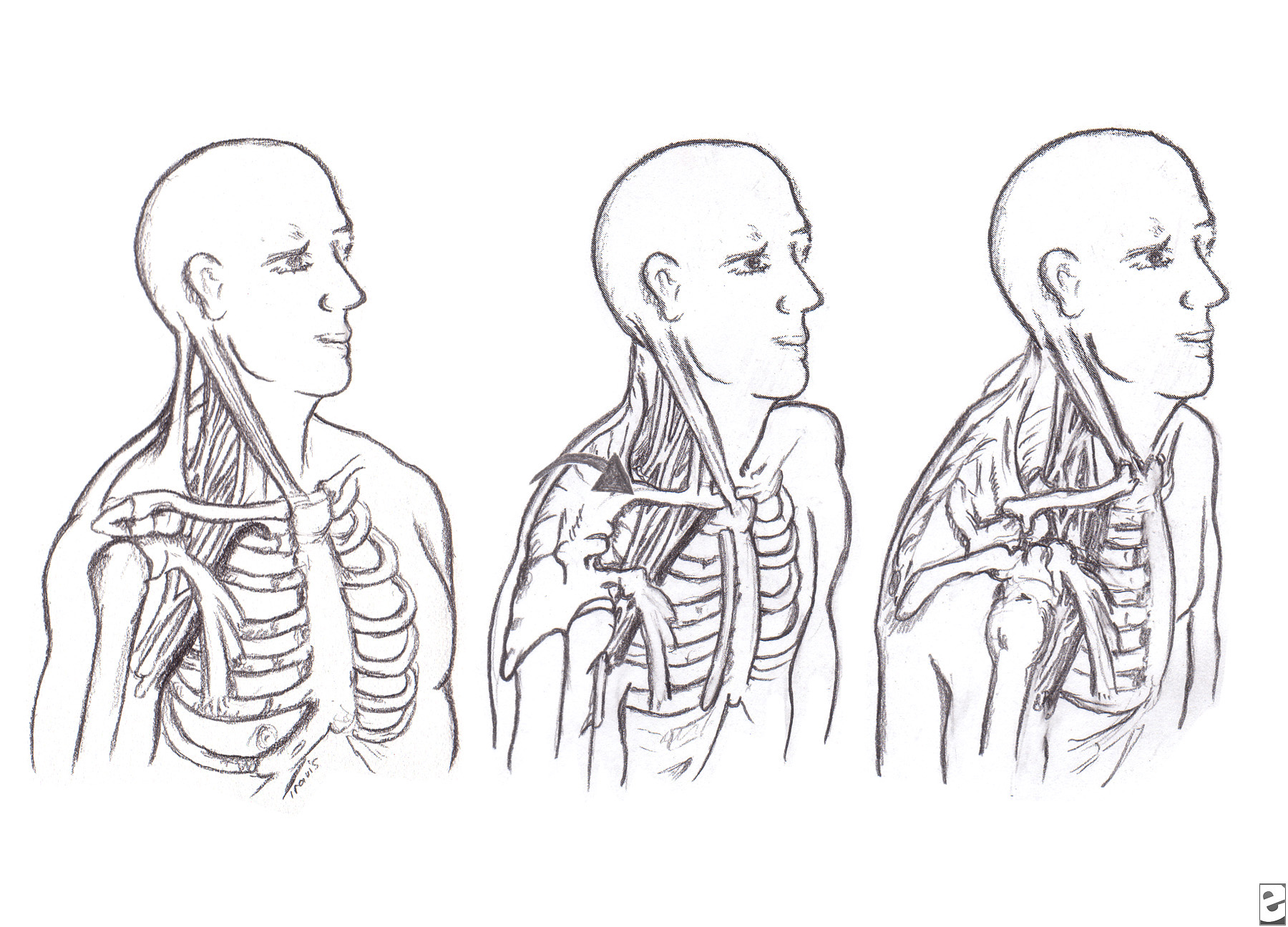
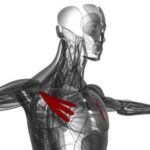
We often find that we can improve posture by opening the chest muscles and fascia. Stretching and opening key tissues in the chest is a vital step in the process of correcting head forward posture and rounding of the shoulders. These postural challenges cause chronic pain, limit range of motion and are precursors to more serious problems.
Restriction in pec minor and related structures is a key element in Upper Crossed Syndrome and most cases of Forward Head Posture.
The Mighty Pec Minor
Pectoralis Minor is a small, but important muscle of the chest. However, perhaps we should think of it as a “front of the shoulder” muscle. It runs from our upper ribs to the coracoid process of the shoulder blade that reaches out past the front of the shoulder joint. Therefore, a tight pec minor rounds our shoulders.
Self-Compression of Pec Minor
 We begin with self-compression using a tennis ball. Locate the area in front of your armpit, near the top of your rib cage. Position the tennis ball against extra molding in a doorframe (the door stop).
We begin with self-compression using a tennis ball. Locate the area in front of your armpit, near the top of your rib cage. Position the tennis ball against extra molding in a doorframe (the door stop).
Then place the area near your rib cage against the tennis ball held in the doorframe. Gently explore, looking for tender areas, and tight bands. If you find some, explore them and try to release these areas with the tennis ball.
Stretching Pec Minor
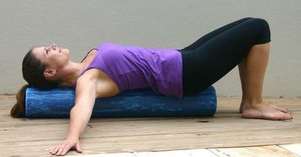 Next, we recommend a “passive stretch” for pec minor, done while lying on a foam roller. This stretch is the easiest exercise you have ever done! Lie down on a foam roller lengthwise. Position yourself on the roller so that it fully supports your head and sacrum. Relax and let gravity do the work for you in a controlled manner.
Next, we recommend a “passive stretch” for pec minor, done while lying on a foam roller. This stretch is the easiest exercise you have ever done! Lie down on a foam roller lengthwise. Position yourself on the roller so that it fully supports your head and sacrum. Relax and let gravity do the work for you in a controlled manner.
If you cannot rest your head on the roller without elevating your chin, use a folded towel or small pillow to elevate it for now. You should not feel awkward or off-balance with your entire spine, feet, hands, and arms supported.
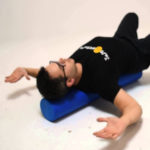 Note that in the second example, the model has his arms hanging in space. They are hanging because of the tightness of his pecs. However, this makes it impossible to relax, and it would be better to support the arms with pillows or a blanket roll until his chest opens further.
Note that in the second example, the model has his arms hanging in space. They are hanging because of the tightness of his pecs. However, this makes it impossible to relax, and it would be better to support the arms with pillows or a blanket roll until his chest opens further.
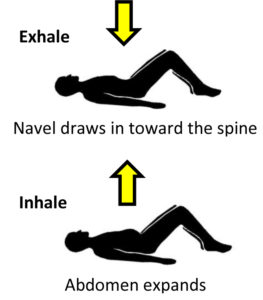 One of the challenges with passive stretching is that it takes several minutes, during which you can’t really do much else. However, this is a great time to practice fully exhaling from the chest along with diaphragmatic (belly) breathing.
One of the challenges with passive stretching is that it takes several minutes, during which you can’t really do much else. However, this is a great time to practice fully exhaling from the chest along with diaphragmatic (belly) breathing.
We focus on exhalation because it helps correctly position our rib cage. Many of us chronically hold our rib cages angled up into an “inspiratory” position. The lower, flatter position associated with exhalation is easier on our chest muscles and is more natural. It is also easier to breathe deeply into your belly once you have exhaled most of the stale air from your lungs.
Note that many illustrations and discussions of diaphragmatic breathing suggest using your hands to monitor and minimize the movement of your chest and to maximize movement of the belly. Feel free to check in with your hands but we want them up overhead, as pictured above, in this exercise.
There are many benefits. To encourage good breathing habits, we suggest placing a small book on your chest and slightly heavier weight on your abdomen to increase awareness.
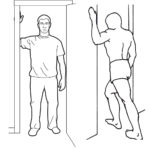 We can stretch our pec minor muscle more actively with a one-arm doorway stretch. In this stretch, place your entire forearm up against the door frame. Then gently step through the doorway with the opposite leg.
We can stretch our pec minor muscle more actively with a one-arm doorway stretch. In this stretch, place your entire forearm up against the door frame. Then gently step through the doorway with the opposite leg.
For instance, at work, this more deliberate stretch may be more convenient than lying down in a passive stretch.
 You can try another more active stretch on hands and knees with a large fitness ball. The action is similar to the doorway stretch.
You can try another more active stretch on hands and knees with a large fitness ball. The action is similar to the doorway stretch.
Extra – Anatomy of Pec Minor
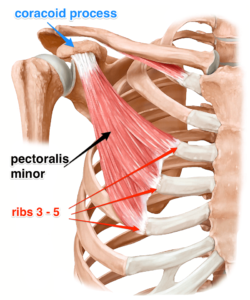 The pectoralis minor is a thin, triangular muscle, situated at the upper part of the chest, beneath the pectoralis major in the human body.
The pectoralis minor is a thin, triangular muscle, situated at the upper part of the chest, beneath the pectoralis major in the human body.
The pectoralis minor depresses the point of the shoulder, drawing the scapula superior, towards the thorax, and throwing its inferior angle posteriorly.
It arises from the upper margins and outer surfaces of the third, fourth, and fifth ribs, near their cartilages and from the aponeuroses covering the intercostalis.
The fibers pass superior and lateral and converge to form a flat tendon, which is inserted into the medial border and upper surface of the coracoid process of the scapula.
The pec minor muscle is covered by the clavipectoral fascia. In attaching to the coracoid process, the pectoralis minor forms a ‘bridge’ – structures (like nerves and blood vessels) passing into the upper limb from the trunk pass directly underneath.
The origin is from the second, third and fourth or fifth ribs. The tendon of insertion may extend over the coracoid process to the greater tubercle. It may be split into several parts. Absence of this muscle is rare but happens with certain uncommon diseases.
